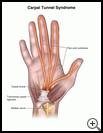
Carpal Tunnel Syndrome
________________________________________________________________________
KEY POINTS
- Carpal tunnel syndrome is problem with pain, numbness, and tingling in your wrist, hand, and fingers. Carpal tunnel syndrome is a common problem for cashiers, carpenters, assembly-line workers, and people who work on a keyboard or with a computer mouse.
- You may need to stop doing activities that make your symptoms worse.
- Treatment may include stretching and strengthening exercises, medicine, wearing a wrist splint, or surgery.
- Your healthcare provider may recommend stretching and strengthening exercises to help you heal.
________________________________________________________________________
What is carpal tunnel syndrome?
Carpal tunnel syndrome is problem with pain, numbness, and tingling in your wrist, hand, and fingers. The carpal tunnel is a narrow space in your forearm and the palm of your hand. It is made up of bone and other tissue. The median nerve passes through the carpal tunnel to your thumb, index finger, and middle finger.
What is the cause?
The exact cause of carpal tunnel syndrome is not known. It is more common in women than in men.
It may be that pressure, irritation, swelling, or blood flow problems in the carpal tunnel damage the median nerve. Irritation and pressure may come from using your hand and wrist in the same motion over and over. For example, carpal tunnel syndrome is a common problem for cashiers, carpenters, assembly-line workers, and people who work on a keyboard or with a computer mouse. Or a broken bone or other injury may damage or put pressure on the nerve.
You may have a higher risk of carpal tunnel syndrome if someone in your family has this problem, or if you are pregnant or have a disease like rheumatoid arthritis, diabetes, or a thyroid problem. Some medicines used to treat breast cancer in women may cause carpal tunnel syndrome.
What are the symptoms?
The main symptoms are pain, numbness, or tingling in your hand and wrist, especially in the thumb and the index and middle fingers. The pain may:
- Come and go
- Get worse the more you use your hand
- Be worse at night
- Feel better if you shake your hand and wrist
Your hand may feel weak. It may be hard for you to grab things and hold onto them with your hand. You may have trouble knowing if something is hot or cold when you touch it.
How is it diagnosed?
Your healthcare provider will ask about your symptoms, medical history, and the ways you use your hands. Your provider will examine you. He or she may tap the middle of your inner wrist or ask you to bend your wrist down for 1 minute to see if either of these tests causes pain or tingling. Your provider may refer you to a specialist for tests to check your nerves. In some cases you may have an ultrasound or MRI scan.
How is it treated?
If you have a disease that may be causing carpal tunnel syndrome, like arthritis, diabetes, or a thyroid problem, treating the disease may help your symptoms.
To relieve pressure on the nerve your healthcare provider may suggest that you:
- Rest your hand and wrist and avoid activities that may make your symptoms worse.
- Wear a wrist splint to avoid more damage from twisting or bending and help relieve pain and numbness.
In some cases your provider may prescribe medicine for pain and swelling or give a shot of steroid or numbing medicine into your wrist.
Your healthcare provider may recommend stretching and strengthening exercises to help you heal.
Your provider may recommend surgery if your symptoms don’t get better with these treatments.
How can I take care of myself?
Some of the things you can do to help your symptoms include:
- Put your arm up on pillows so that it is above the level of your heart when you sit or lie down.
- If your work involves using tools, try using a different tool, or try to use the other hand instead.
Follow your healthcare provider's instructions, including any exercises recommended by your provider. Ask your provider:
- How and when you will get your test results
- How long it will take to recover
- If there are activities you should avoid and when you can return to your normal activities
- How to take care of yourself at home
- What symptoms or problems you should watch for and what to do if you have them
Make sure you know when you should come back for a checkup. Keep all appointments for provider visits or tests.
How can I help prevent carpal tunnel syndrome?
Because the exact cause of carpal tunnel is not well understood, it can be hard to prevent. Here are some things you can do that may help:
- Make sure that your hands and wrists are supported when you use them, especially if you do repetitive work. For example, when you are typing or using a mouse at a computer, make sure your workstation is set up in the proper position and that your hands are comfortably supported in front of the keyboard. It may help to use a pad that is specially designed to give this kind of support. Also check to see that your forearms are at the same level as your keyboard.
- Make sure that the tools you use are not too large for your hand. Try to use tools with a cushioned grip, or wear gloves when you use them. Some workplaces provide tools or equipment that may help you avoid carpal tunnel syndrome. Ask your employer about this.
- Take frequent breaks from your work and do carpal tunnel exercises.
It’s not clear, however, that making these changes will help prevent carpal tunnel syndrome.

